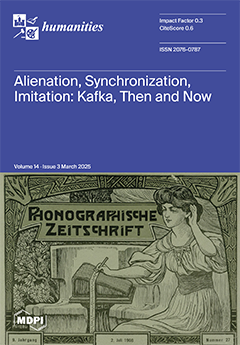This essay analyzes The Untitled Othello Project (UOP) created by Keith Hamilton Cobb. Originating out of conversations around his play
American Moor and coinciding with George Floyd’s murder and the period of racial unrest and reflection in the United States, UOP is a
[...] Read more.
This essay analyzes The Untitled Othello Project (UOP) created by Keith Hamilton Cobb. Originating out of conversations around his play
American Moor and coinciding with George Floyd’s murder and the period of racial unrest and reflection in the United States, UOP is a transformative approach to Shakespeare studies around issues of pedagogy and performance. Rooted in Cobb’s frustration with systemic racism and exclusion in the capitalist American theater as depicted in
American Moor, UOP applies a method called “untitling”, a collaborative and reflective process of dismantling and reimagining Shakespeare’s
Othello beyond its origins. This essay examines UOP’s interdisciplinary methods. As a collaborator and witness to UOP residencies at Sacred Heart University, I argue that the untitling methodology deploys phenomenological hermeneutics, reparative reading, and critical pedagogy, drawing on Ricoeur, Sedgwick, Boal, and Freire in the context of recent developments in critical race studies, especially through scholars of RaceB4Race and #shakerace. The untitling process requires slow, collective readings of
Othello, focusing on identity, language, and the racist, patriarchal, and ableist social constructs propping up Shakespeare’s play. By inviting diverse voices—including actors, scholars, students, and audiences—to the table, UOP privileges the human beings in the room over the canonical text. UOP resists universalizing readings of Shakespeare’s play and, with a spirit of inquiry, encourages collaborative authority to lift up marginalized perspectives. This essay establishes UOP within the context of Shakespeare performance pedagogy, seeking to define its affordances for humanities study at the college level.
Full article





